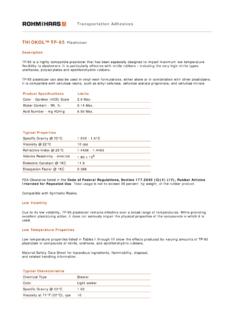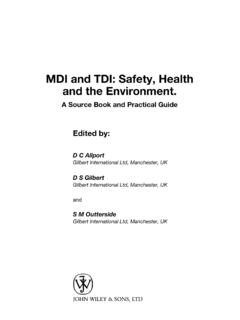Transcription of General Processing Information - XDC
1 VIBRATHANE General Processing Information COMPOSITE DATA CROMPTON CORPORATION CHEMICAL offers the most versatile line of liquid urethane prepolymers and curatives in the market today. These prepolymers and curatives, called ADIPRENE , VIBRATHANE , AND VIBRACURE respectively, are used worldwide wherever high performance is demanded. TDI- and MDI- terminated resins are available as polyether and polyester types. In addition, CROMPTON CORPORATION CHEMICAL offers medium performance polyether prepolymers for many applications where the ultimate in urethane physical properties is not required. The ADIPRENE products are summarized in a separate bulletin.
2 Ether-Ester Comparison Because of inherent advantages in low hysteresis (heat build-up), polyether VIBRATHANE is recommended for applications where parts undergo dynamic stress. Ether VIBRATHANE yields urethanes having important advantages in resilience, low-temperature performance and hydrolytic stability. Polyester VIBRATHANE gives urethanes with superior cut, tear, and abrasion resistance as well as having an inherent advantage in oil resistance. Polyether VIBRATHANE has lower process viscosity and lower specific gravity compared to polyester VIBRATHANE. Urethane Prepolymers MDI-TDI Comparison MDI VIBRATHANE gives lower isocyanate odor than similar TDI types and cures to form urethanes with superior hydrolytic stability.
3 TDI VIBRATHANE has major advantages in Processing characteristics, including less sensitivity to moisture, shorter demold time, and milder cure requirements compared to MDI VIBRATHANE. VIBRATHANE General Processing CHARACTERISTICS Medium Performance VIBRATHANE Medium performance polyether VIBRATHANE has proven itself in many field applications including certain press-on tires. While not recommended for all applications, it can sometimes match the performance of other urethanes at substantial cost savings. Low VIBRATHANE temperatures (see data sheet) are recommended when Processing medium performance VIBRATHANE, especially where adhesion to metal is important.
4 Curatives VIBRATHANE terminated with TDI is normally cured with diamines like 4,4 methylenebis [orthochloroaniline] , commonly called MBCA, for urethanes above 70 Shore A, ETHACURE 300 Curative can be used as a MBCA alternative for most applications. Polyol curatives result in softer materials for applications such as printing and coating rolls. Commonly used polyols include VIBRACURE A-931, TP30LW , trimethylopropane (TMP) and Pluracol TP4404. VIBRACURE A-931 gives low durometer urethanes with tear strengths superior to other polyols, and is especially useful to avoid heavy use of plasticizer. VIBRATHANE terminated with MDI is usually cured with diol extenders 1,4-butanediol5 or HQEE6 for urethanes above 70 Shore A and with VIBRACURE A-120 or VIBRACURE A-125 for elastomers down to 55A.
5 These urethanes have proven to be viable non MBCA systems as established by successful field performance in virtually all major applications. VIBRACURE A-120 is useful with polyether-MDI or TDI VIBRATHANE and VIBRACURE A-125 with polyester-MDI or TDI VIBRATHANE. Many combinations of curatives are useful to meet specific property or Processing requirements. FDA Approval VIBRACURE A-125 and/or 1,4 butanediol, as curatives, and VIBRATHANE 6012, 8007, 8094 and 8095, as prepolymers are castable systems having FDA approval for use with wet foods. All VIBRATHANE has approval for use with dry food, but many curatives, including 4,4methylenebis (orthochloroaniline), do not.
6 Consult CROMPTON CORPORATION CHEMICAL for more details6. The data in this bulletin provide a ready means for comparison of the many VIBRATHANE types. Only data on urethanes above 70 Shore A are presented. Data on lower durometer urethanes as well as more details on specific prepolymers and curatives can be found in the individual VIBRATHANE and VIBRACUE bulletins. 1 Activator M, MVR Corporation 2 Perstorp 3 Celanese Chemical Corporation 4 BASF Wyanodotte Corporation 5 BASF Wyanodotte Corporation 6 Crompton Corporation Chemical Vibrathane Technical Service: 1-800-243-2650 VIBRATHANE General Processing CHARACTERISTICS Shelf Life VIBRATHANE has a shelf life of two years when stored at temperatures less than 75 F (24 C) and kept sealed from moisture.
7 This is the longest stated shelf life in the industry and is indicative of the excellent stability of VIBRATHANE. VIBRACURE has a shelf life of five years under the same conditions. Heat Stability The NCO content of all prepolymers decreases with time on exposure to heat. The rate of this loss depends on the temperature, the initial NCO content and the type of isocyanate termination. Data are shown below for VIBRATHANE B 601, a NCO, TDI-terminated prepolymer. Stability generally decreases slightly as initial NCO content increases. MDI types have similar stability. Tolerable Heating Time as a Function of Temperature VIBRATHANE B 601 Temperature, F ( C) Time 140 (60) 2 weeks 160 (71) 3 days 180 (82) 36 hours 200 (93) 12 hours 212 (100)
8 8 hours Storage VIBRATHANE should be stored unopened in its air tight container at 50-90 F (10-32 C). The isocyanate content of all prepolymers can be decreased by reaction with moisture. It is recommended that partially emptied containers be swept free of atmospheric moisture with dry nitrogen before sealing. Handling Some VIBRATHANE is a liquid at room temperature. This characteristic allows facile handling and easy transfer to casting equipment. All prepolymers have a molecular weight distribution and certain portions may separate on freezing and re-melting.
9 It is recommended that containers of VIBRATHANE or VIBRACURE that require melting be rolled prior to use to ensure homogeneity. Melting should be carried out at 140-160 F (60-71 C). VIBRATHANE General Processing CHARACTERISTICS Toxicity VIBRATHANE contains reactive isocyanate groups and should be handled with care. Avoid inhalation of vapors and skin contact. These materials are known to cause skin irritation and respiratory difficulties on severe or prolonged contact. Safety glasses should be worn and proper ventilation supplied. Normal safety precautions should be taken when handling VIBRACURE. Consult the individual Material Safety Data Sheets (MSDS) and our brochure titled Toxicity and Handling of ADIPRENE/VIBRATHANE for further details.
10 Effect of Curative Level The molder of a cast urethane part has considerable control over which physical properties are maximized. All physical properties are maximized. All physical properties are sensitive to curative level to some extent. At low stoichiometry (less than 100% theoretical amount of curative) the urethane tends to be more thermoset in nature and above 100% theory it becomes more thermoplastic. No one curative level maximizes all properties. Consult CROMPTON CORPORATION CHEMICAL if in doubt about the proper curative level for the application. The following physical properties are sensitive to curative level and are affected as described.








